Table of Contents
Growing Pains: An Introduction into Backcountry Skiing.
It was silly, but I had this grand idea that I would naturally be able to back country ski because I am a good downhill skier, backpacker, and comfortable walking on snow.
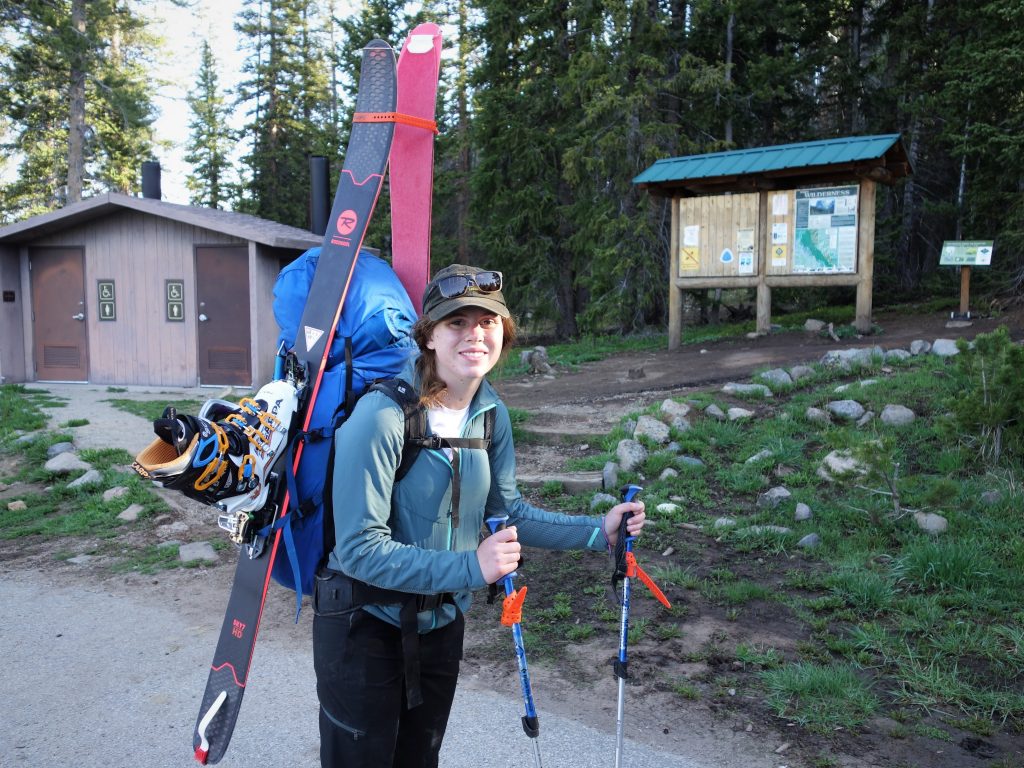
But skinning is a whole other game.
Skinning is like lunging your way across a hill; it is not like walking. While side-hilling in melting snow (which was most of this trip), skis want to slide downhill against your desire. When you do get to ski downhill, that does not necessary mean you clip in and rip your skins. Sometimes you aim your out of control pizza, with bindings detached, boots loosened, wearing a five-day pack, lurching forwards and backwards, and your core strength is the only thing that prevents you from falling backwards.
This is assuming there is even snow to ski on.
Day 1: Approach to Seneca Lake
The snow alternated between 20ft of post holing snow and 20ft of bare rocky trail for 15miles. In addition, the terrain went up and down 100ft, but it never gained enough or lost elevation to be pure snow or dirt. Thus, the trail was not flat, but it didn’t take us anywhere.
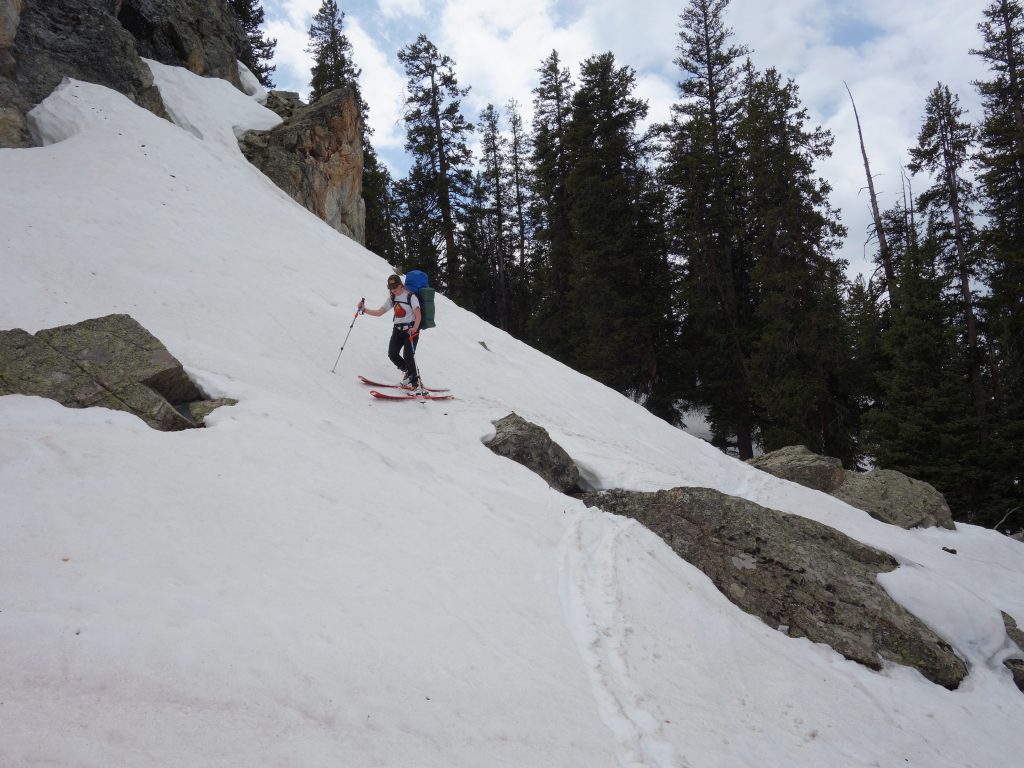
Being my first ski tour, I had not mastered transitions by any means, so I was slow, to say the least. Slow to take my skies on and off. Slow to decide to carry them or attach them to my pack. Slow to transition into ski boots or remain in soaked sneakers.
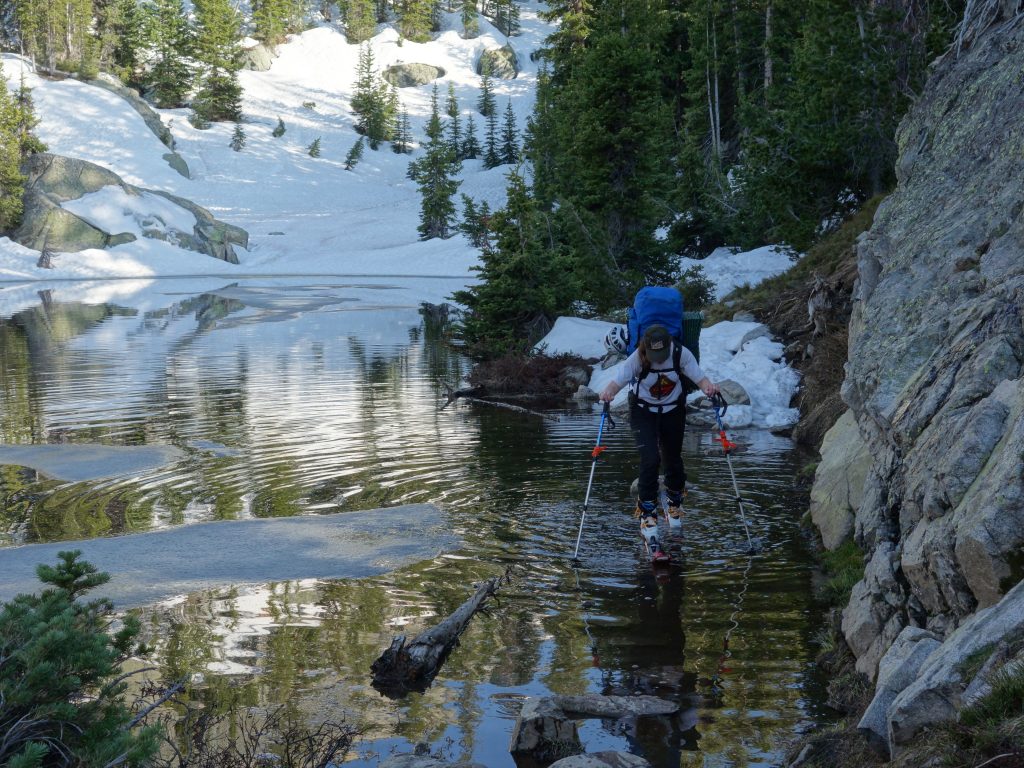
It took as unexpected two days to reach Titcomb Basin, so we spent the first night at the beautiful Seneca lake. Fortunately, it was a partially frozen wonderland. I may have been to exhausted to set up camp or make dinner, but Kyle was a wonderful partner who kept the moral up high.

Day 2: Seneca Lake to Titcomb Basin
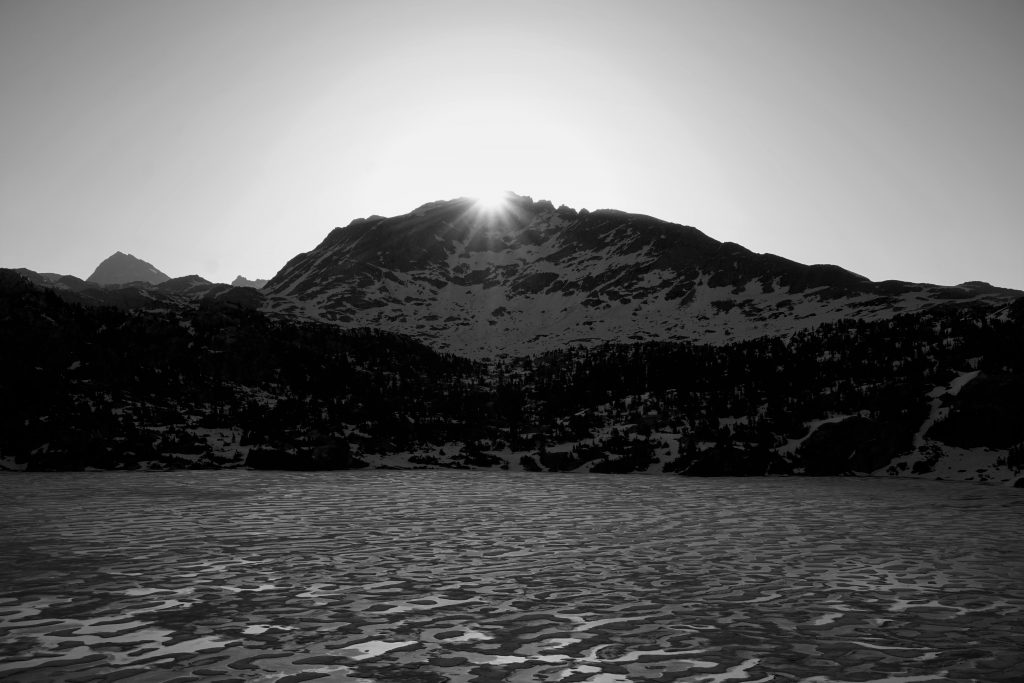
The next morning, we started off with the same partial snow challenges as the day before.
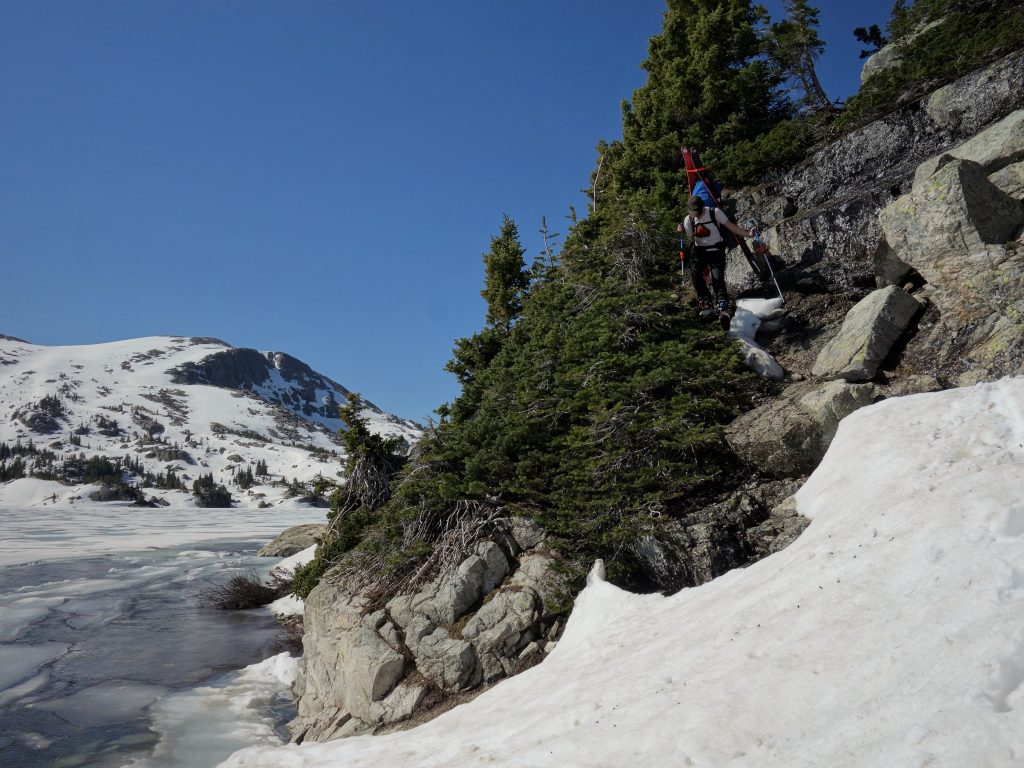
However, by mid-morning, we started to reach alpine terrain. The skinning became much easier, and the mountains became even more impressive. I started to become more excited about our objective.

When we finally reached Titcomb Basin, I could see why it was such a desirable location to camp in the summer. The mountain faces were beautiful and the frozen lakes were stunning. My feet may have been blistered and torn, but the sky was blue. We saw so many marmots and squirrels, the scenery was amazing.
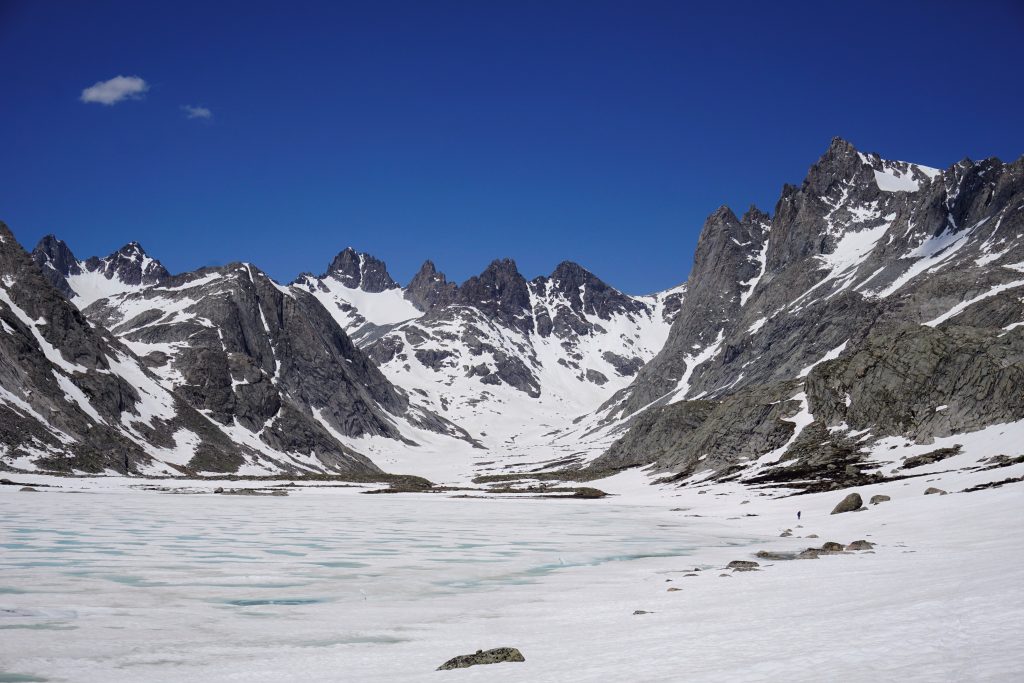
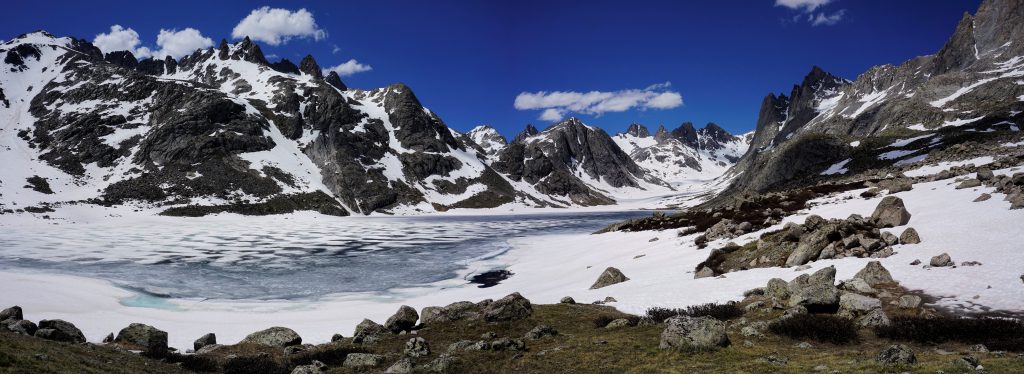
The faces were so big in Titcomb Basin. It got me stoked for our return in August to do some rock climbing.
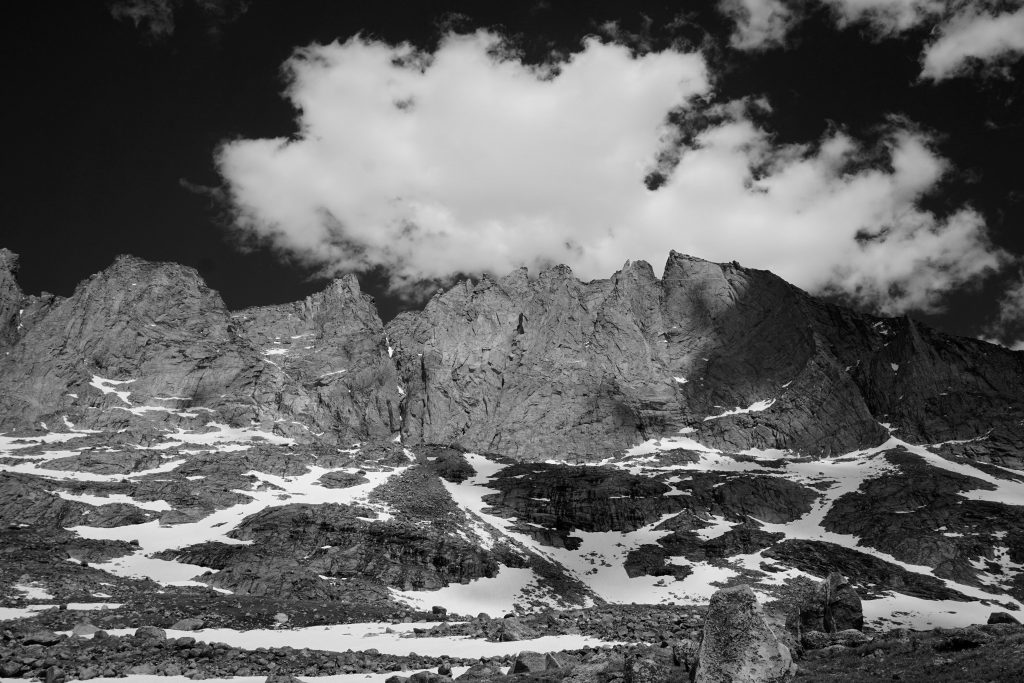
We were the only people camped in the entire basin. We were able to find a relatively dry flat spot to put the tent. But in the 40-50mph wind guests, we were really trusting our tent pitch. As you can see from the picture below, there was nowhere protected we could pitch. The Big Agnes tent held up; it’s a trooper.
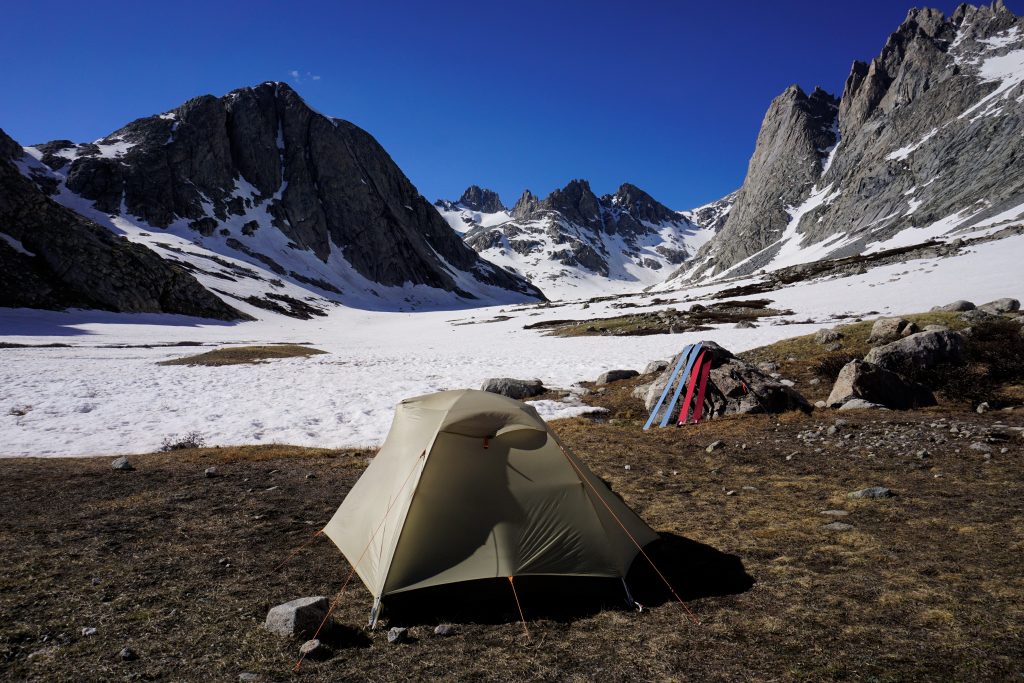
Day 3: Summit Day
Day 3 started at 4:30am. It was summit day. We skinned up to the start of Bonnie Pass no problem just as the sun started to rise.
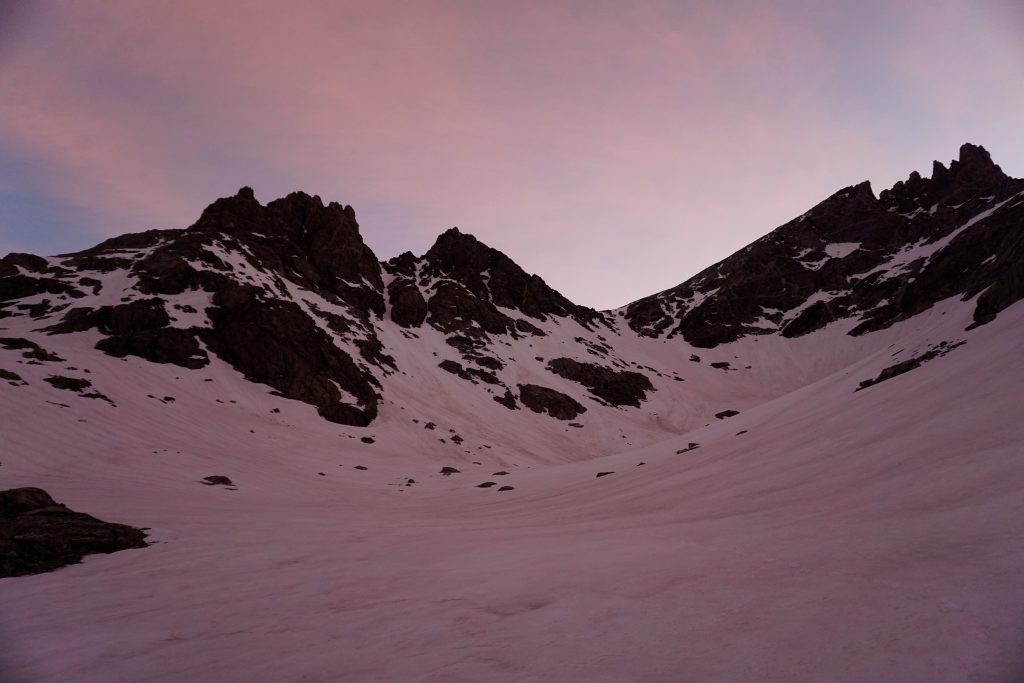
The icy snow made it challenging for me to feel safe going up the couloir to Bonney Pass. I ended up needing to boot up most of the climb, and this felt like a premonition for the additional 3000ft that I would need to climb that day. It was slow and painful.
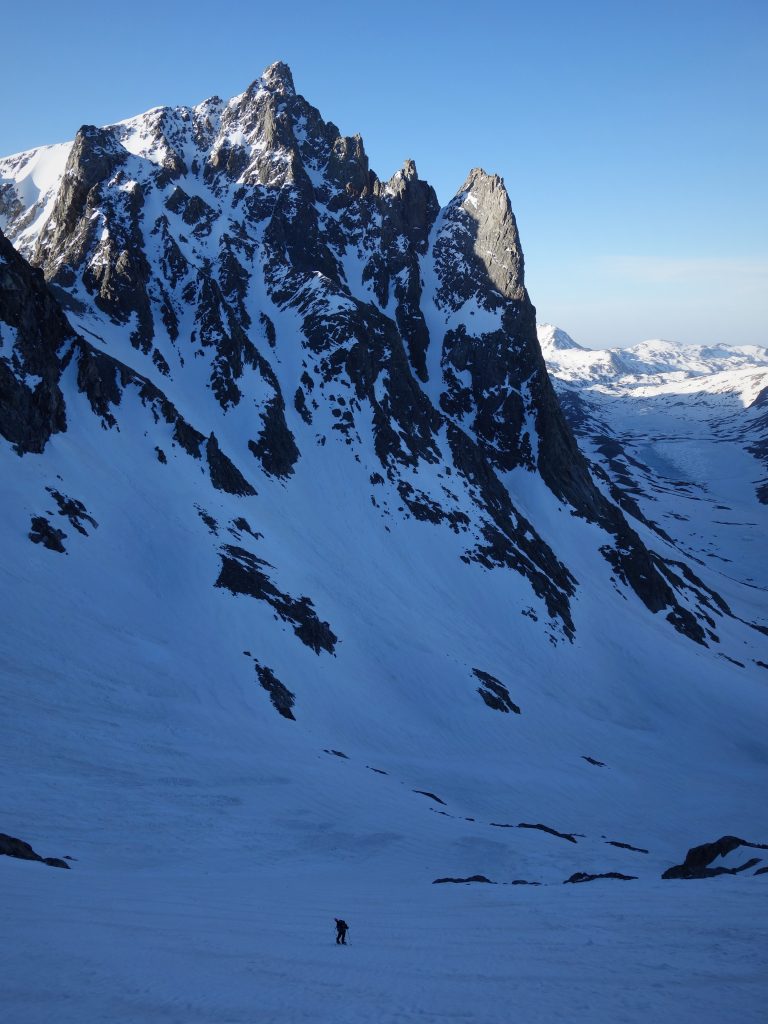
At the pass we were able to see our route to the summit. It looked like an awesome ski descent. I took a while at the pass to seriously debate if I could climb the distance and elevation of Bonney Pass three more times that day. I could tell that the time I had spent in Japan the week before was not helping me at 13,000ft elevation. However, I decided to suck it up and go for the summit. We had already spent 2 days trying to get this far, so I wanted to give it my best go.
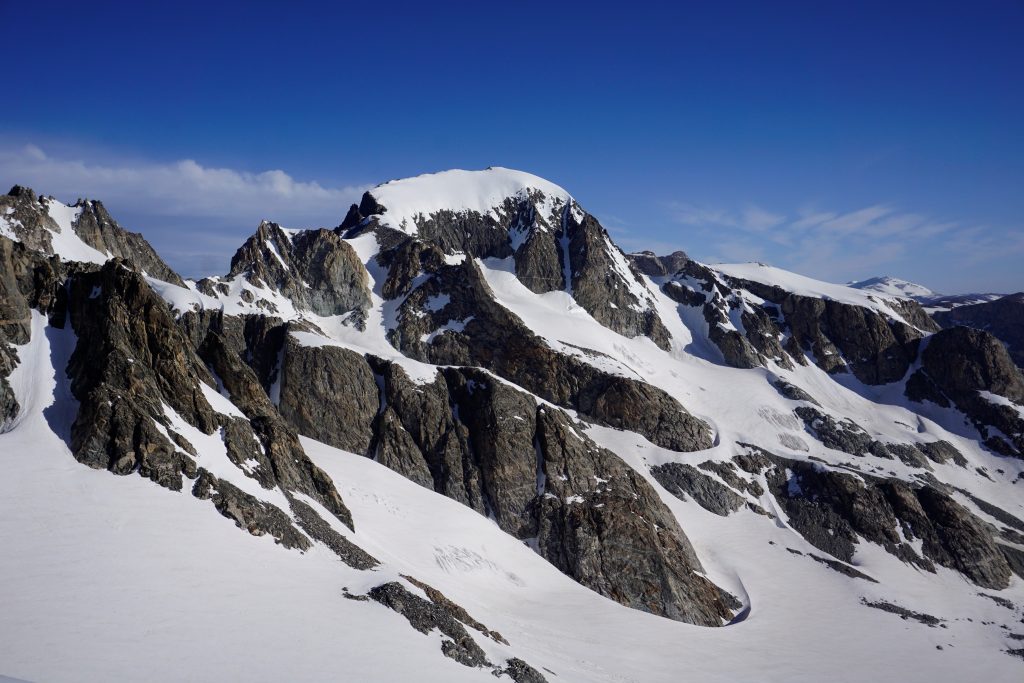
We dropped into a beautiful 30 degree open bowl. The spring turns were awesome, and I was very excited for the longer run off the summit.
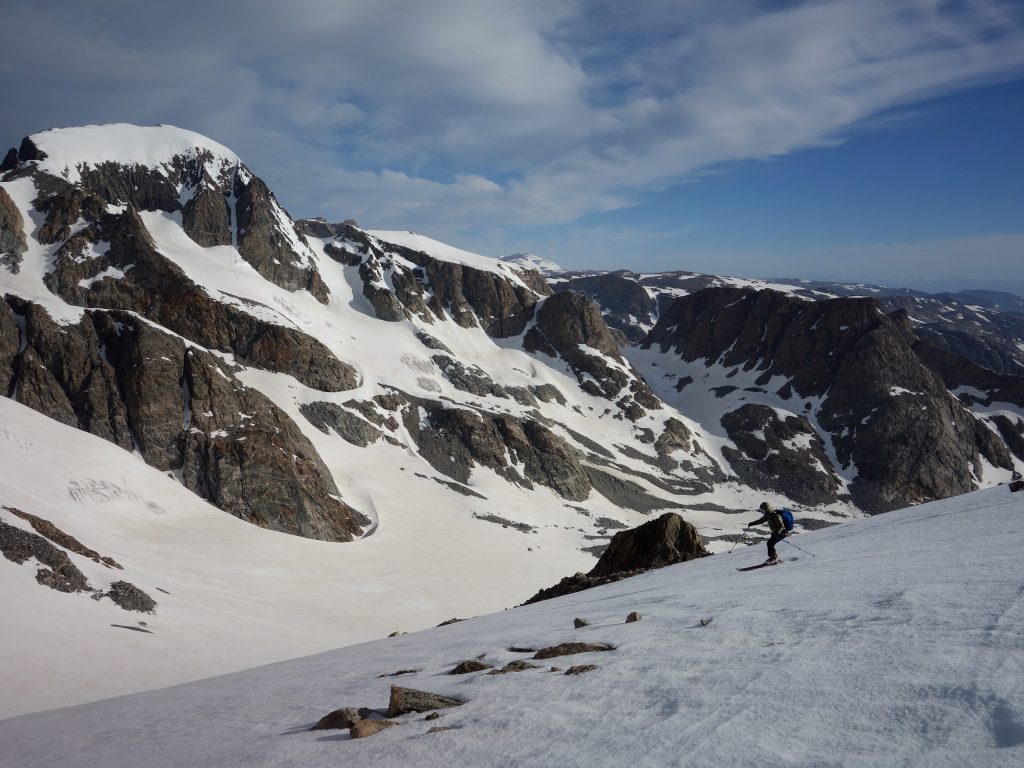
The next 1000 ft of skinning went smoothly. With the nice ski crampons working as training wheels, the skin up was not stressful. When we reached the start of the 45 degree couloir, our paced slowed down.
Kyle became the trip leader at this point. He made it possible for me to reach the summit.
He carried both sets of our skis while stamping out a boot pack through this steep section. Later we read that this glacier was rated as AI2 on SummitPost, and he did not feel the need for crampons or and ice ax. I trudged up slowly behind him.
I eventually started to help carry my weight and skis once we exited the Dinwoody glacier.
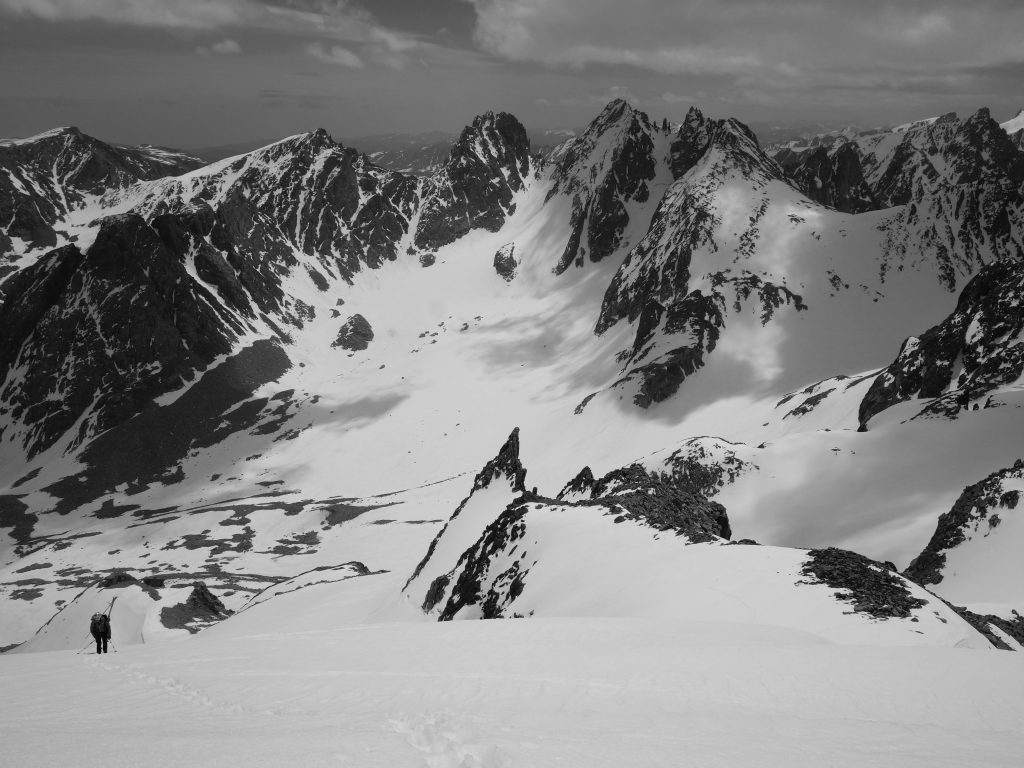
After we scrambled 200ft through a boulder field, we kept marching up in the wind. At this point, I decided to put on crampons. I was also cold enough to be climbing in all my layers.
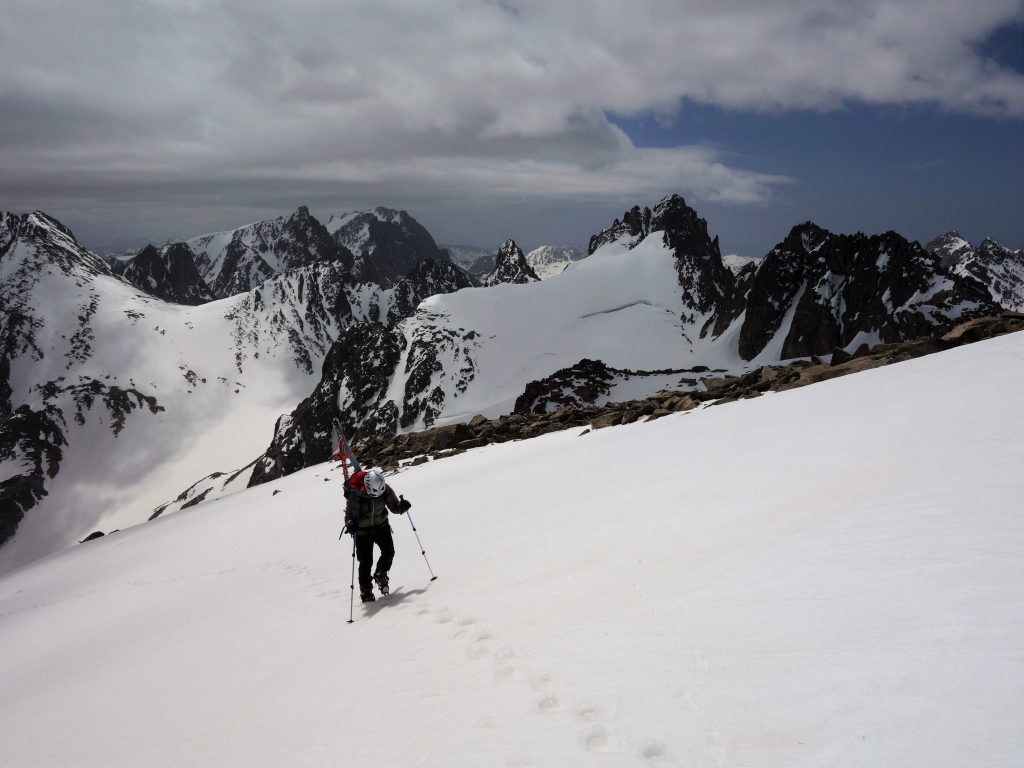
When we reached the final snow field we took a break to decide the best options. We noted that the terrain was no-slip-terrain; it was unlikely we could self arrest before sliding off the cliffs below.
My legs felt like jello, and I had trouble trusting my ski boots on the rocky terrain. My first response to the proposition of summing was “No.” However, after we spent some more time evaluating, I decided to try and walk up the additional 150ft to the summit.
Final snowfield to the summit of Gannet Peak.
As we continued up, the wind was crazy! Gusts were at 50mph, and my skis were acting like sails. I started notice dark circles around my vision, and I was concerned that I might pass out. So I told Kyle he could walk to the true summit and I would rest on the ridge.
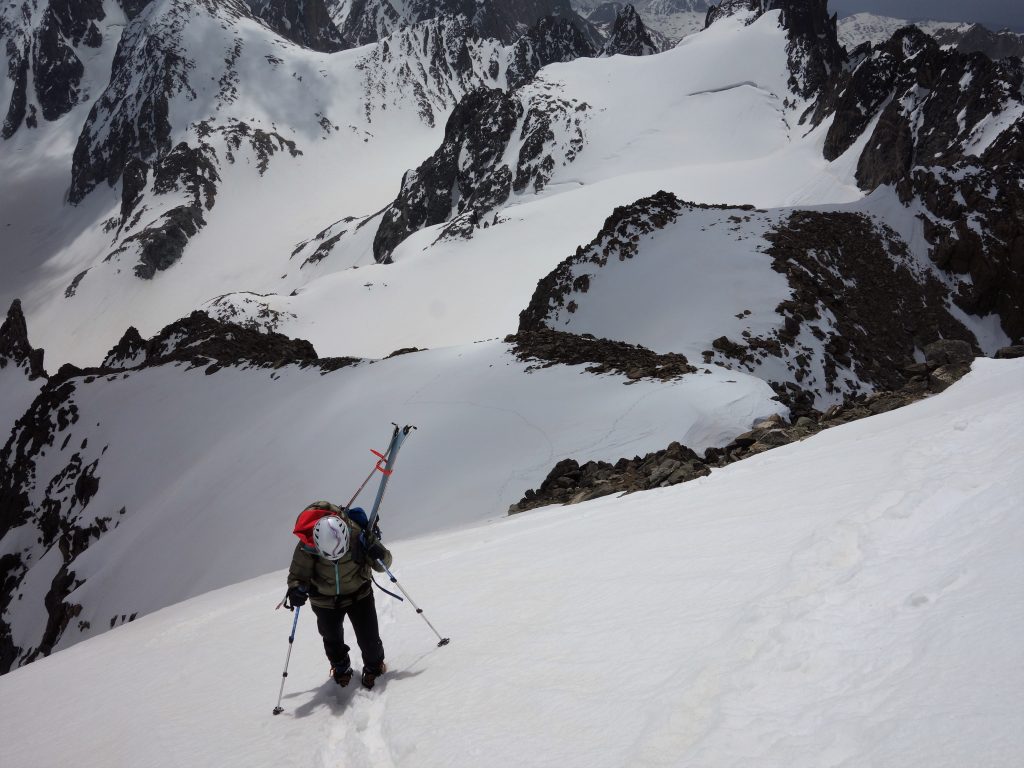 Steep terrain Kylie hikes up on Gannet Peak.
Steep terrain Kylie hikes up on Gannet Peak.
With a 270 degree view, I felt content staying on the ridge looking to the south. In the freezing cold, with snow blowing around, I stamped out a nice platform to rest safely. And then I fell asleep! in the snow! in the cold! Kyle woke me up 30 minutes later after he reached the summit and returned.

We both took our skins off and started down the peak.
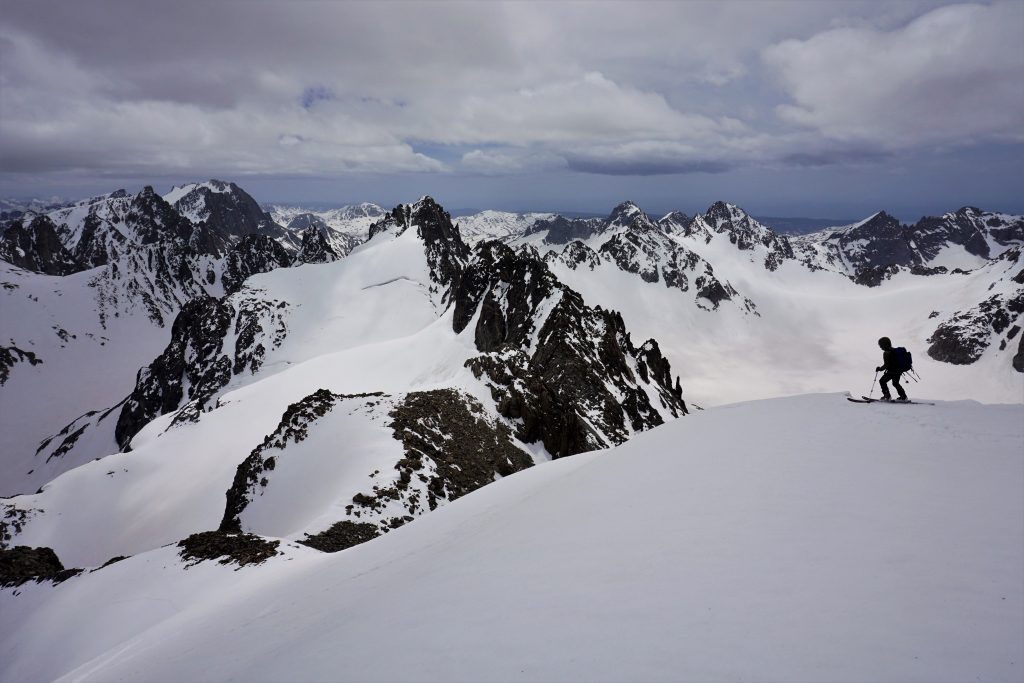
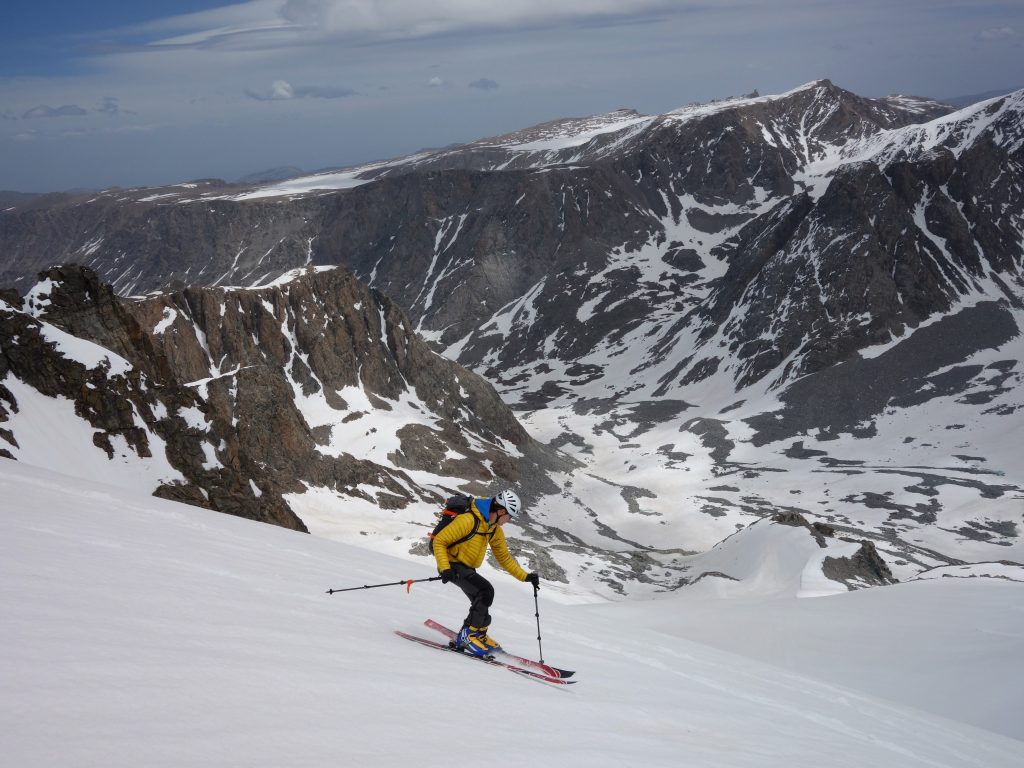
Each turn was slow and painful. I was concerned with the possibility that I would not have the strength to hold a turn.
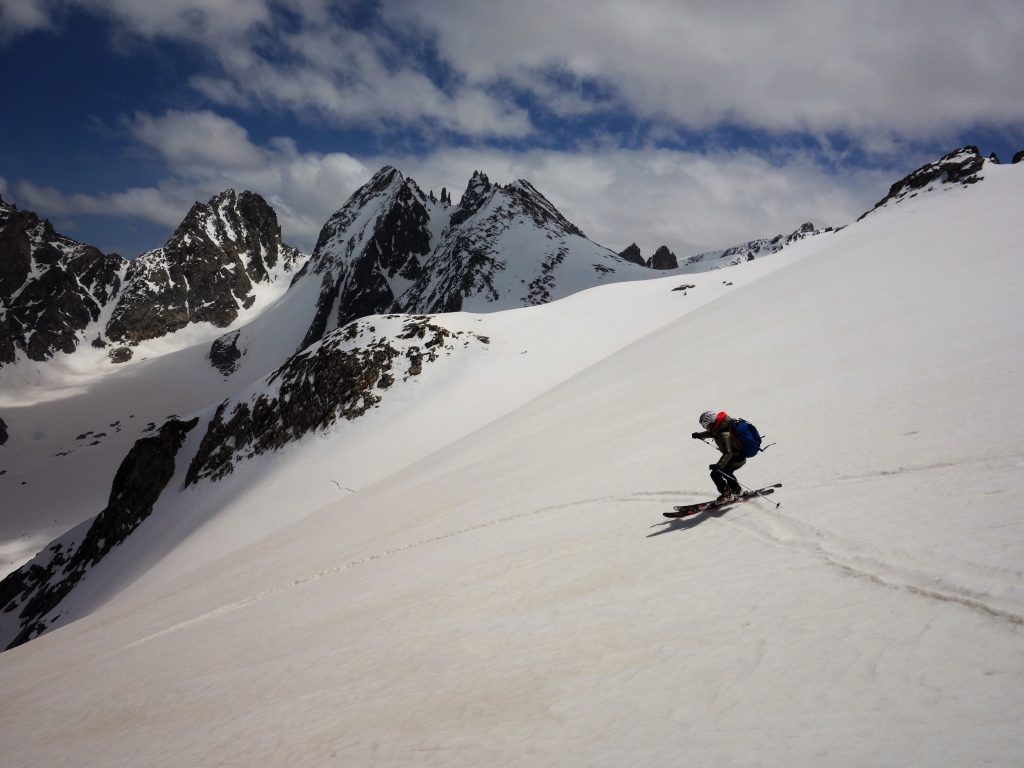
Climbing down the rock field to Dinwoody Glacier was so slow. It took like 45 minutes to descend 200ft. I would take two steps, then I would wait a few minutes for the wind to die down. Take two steps, and wait. I was dizzy, and my legs hurt really bad. I was concerned that any gust would blow me over and I would fall down into the rocks.
Finally, we skied down the steep, narrow, and icy direct couloir. In most situations, I would not have been intimidated by this descent, but I felt like I could barely put weight on my edges because my legs were so weak. It was really scary.
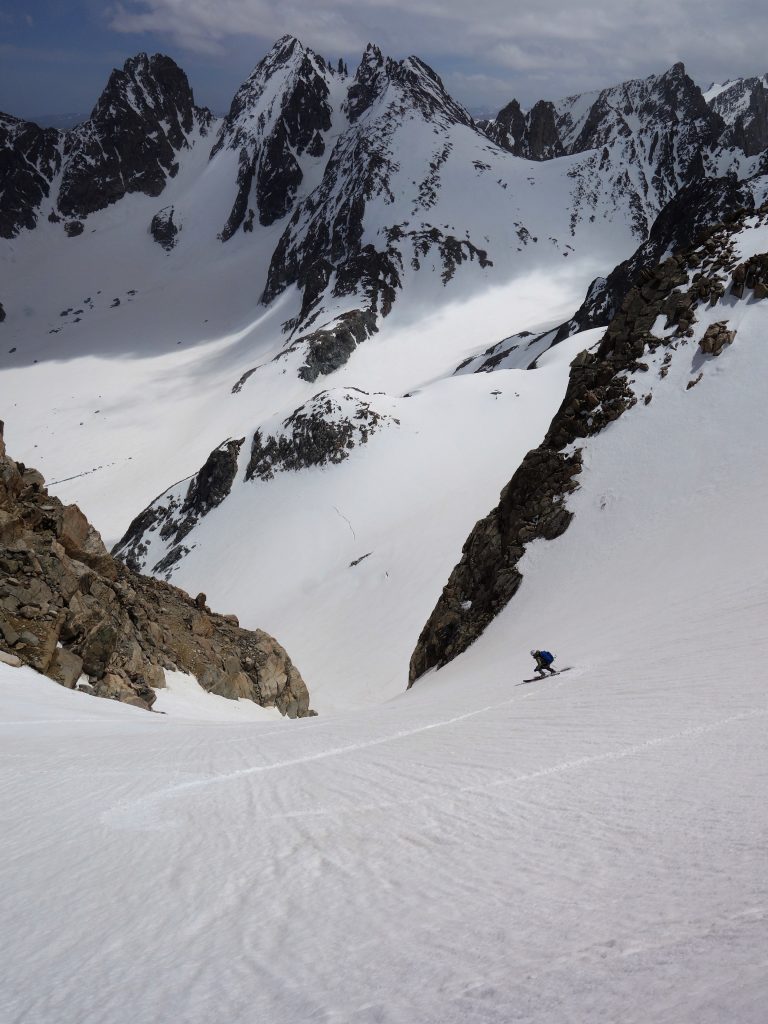
The ski out of the couloir into the bowl was alright. We had to avoid the broken crevasses and large boulders. When we finally came to a stop, I felt like my legs were going to crumble.
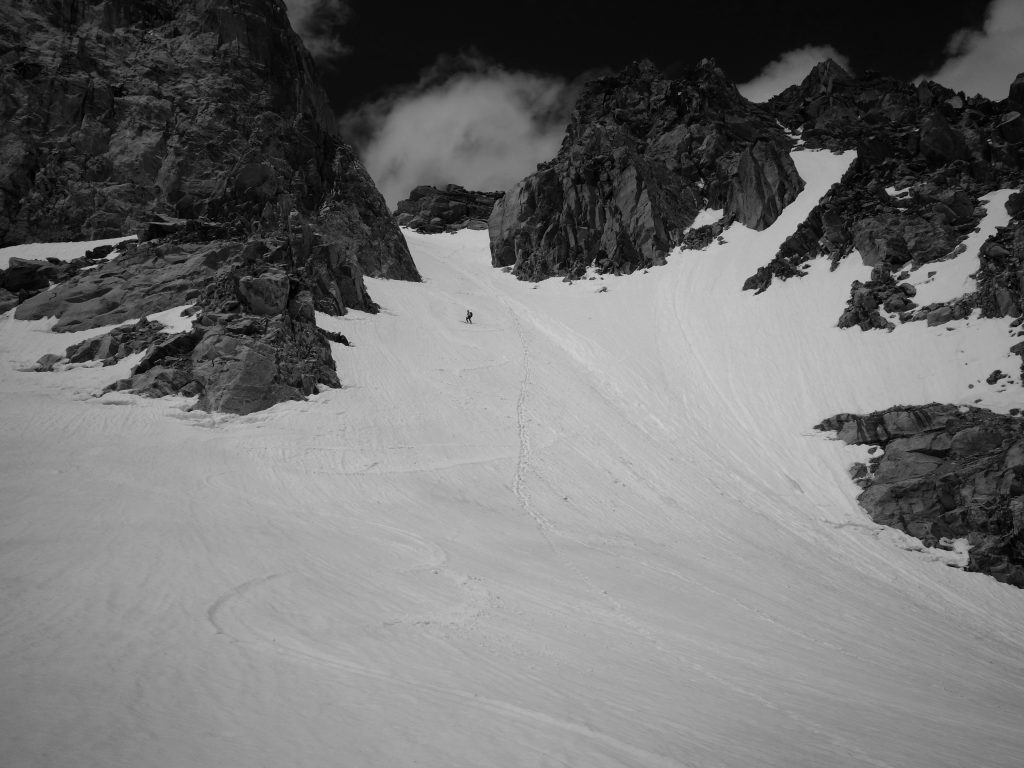
We put our skins on and slowly started moving up to Bonnie Pass. The wind was freezing, and I felt so bad for Kyle. My heart rate was skyrocketing to keep me warm, but at my slow pace, all Kyle could do was freeze.
Kyle took my skis and skinned up to the top of the pass. I trudged on in the leftover boot pack from the bad ass military snowshoer we had met in the parking lot. It took so long for me to make it to the pass that Kyle came back down and took my backpack and carried it up for me.
I kept taking my tiny steps hoping I would eventually make it to the pass.
Kyle came back down for the third time to ask if I thought we would make into camp in the next four hours. I told him “Yes.”
When I eventually make it to the top of Bonnie Pass, Kyle had ibuprofen, a snack, water, and my skis ready to go.
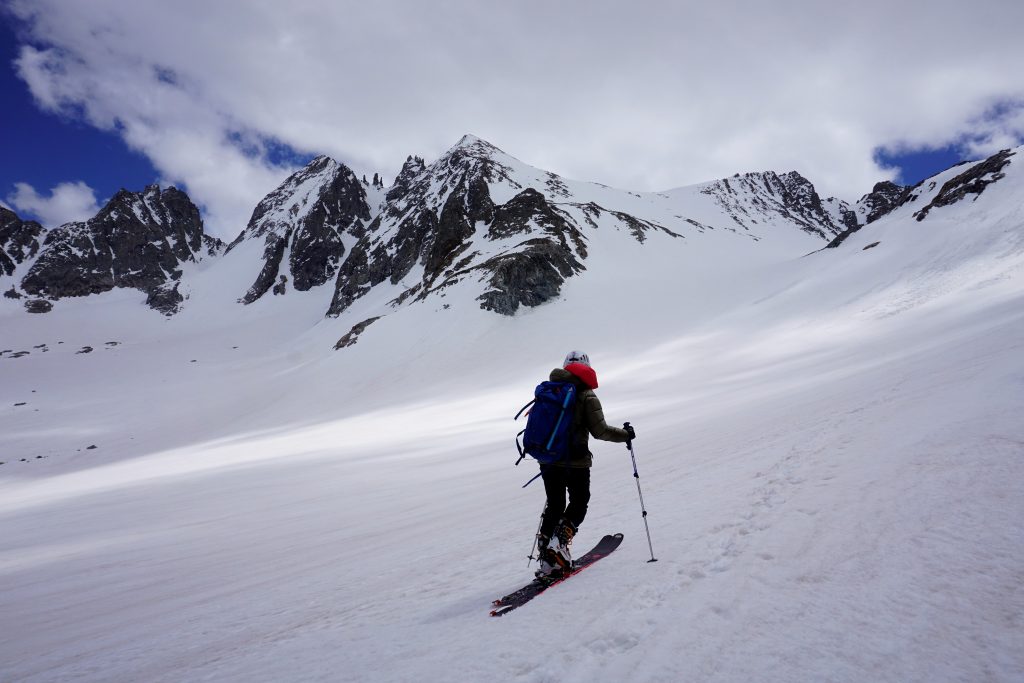
The pass was completely wind swept, and my turns down were skiddy and ugly. I made it down resting every 3-4 turns. The sun-cupped snow had frozen over in the afternoon, and I was too tired to absorb the impact. So, I jostled up and down all the way to our camp.
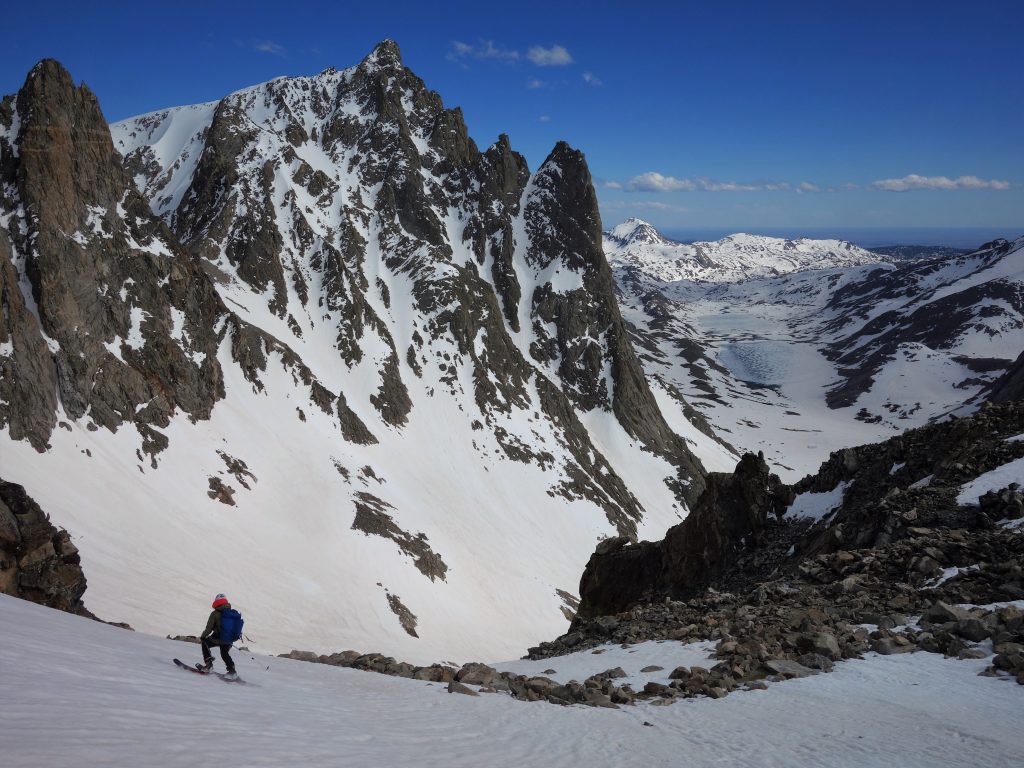
When we got to camp, I immediately crawled into my sleeping bag; I still had on all my clothes including two puffy jackets and my ski boot liners.
Kyle did everything for camp that night. He made dinner that I did not eat, filtered water, and tied down everything from the insane gusts of wind. I had chills all night, and my blood sugar spiked out of control into the 300s.
Day 4: Back to near Seneca Lake
We decided to sleep in this morning. After packing up camp, we skinned back out through Titcomb Basin.
The lakes were so frozen, we could skin across the edge of the lake to avoid taking our skis off.
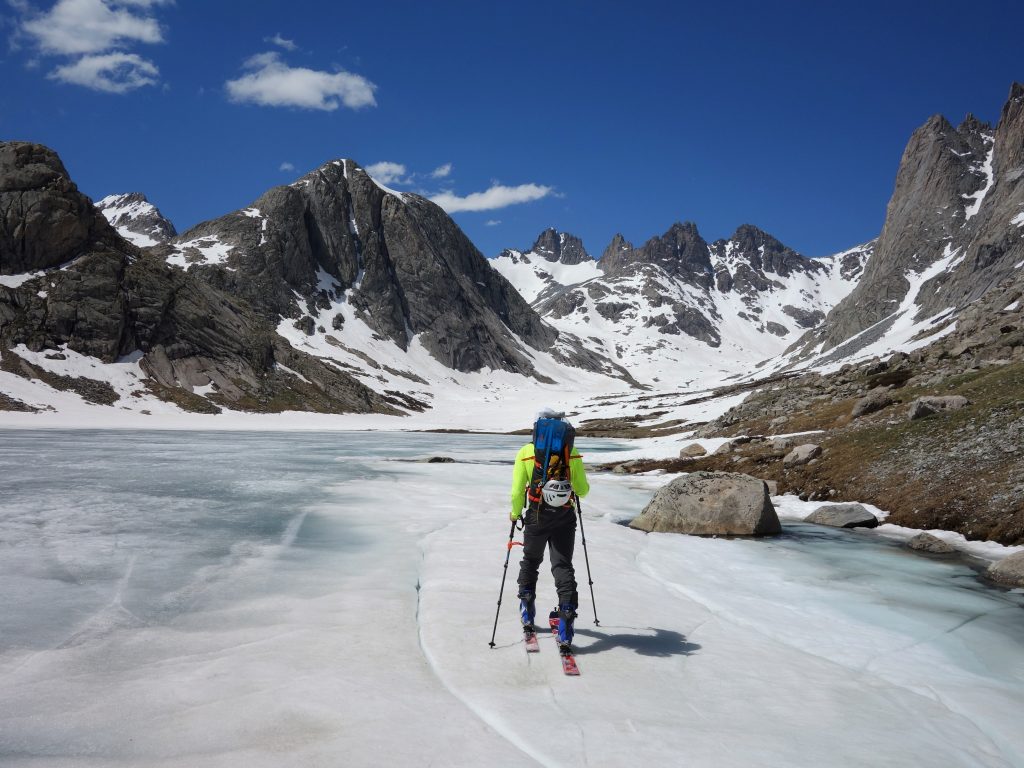
By the time we had reached Iceberg lake, I was finally starting to get the hang of skinning. I was feeling much more speedy and confident. I was a nice change of pace.
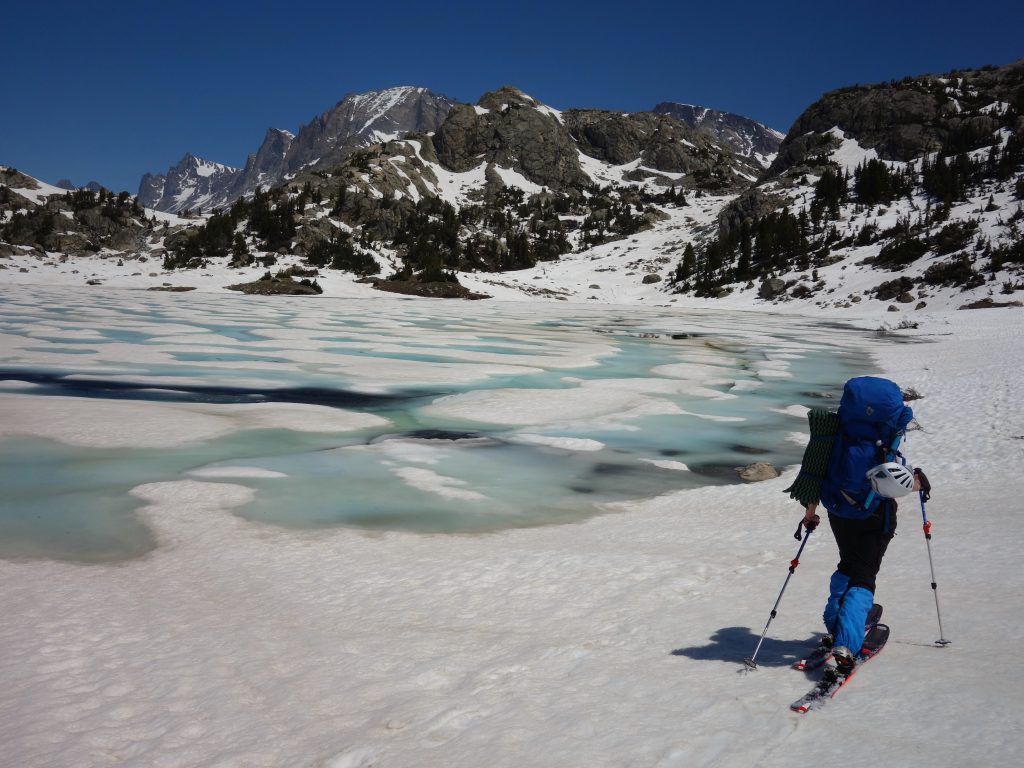
For the afternoon, Kyle decided to ski off some random peak in the distance. I needed an easier trip, so I stayed back to set up camp.
Aside: Lester Peak
Arriving at camp in the early afternoon, I felt a little disappointed by how little actual skiing we were doing over this 5 day trip, although I was not angry at Kylie or anything for the difficulties she faced. Still, I felt the urge to salvage the trip and get in some good skiing. From camp, there was a broad peak with a nice looking 45 degree couloir that split the face on the right side. The map we had did not cover the area of this peak, so I did not even know its name or the terrain to get to it, but I decided to impulsively go for it anyways. It was one of those moments you dream of: see the line, ski the line. Nothing gets more pure than that.
I skinned quickly in the warm afternoon sun up a short series of drainages that appeared to lead to the mysterious peak. Soon, I got to a few small frozen lakes. They seemed pretty solid, so I started skinning across them. At one point, I started to break through the ice, which scared me a little, but I managed to weave through the chunks of ice.
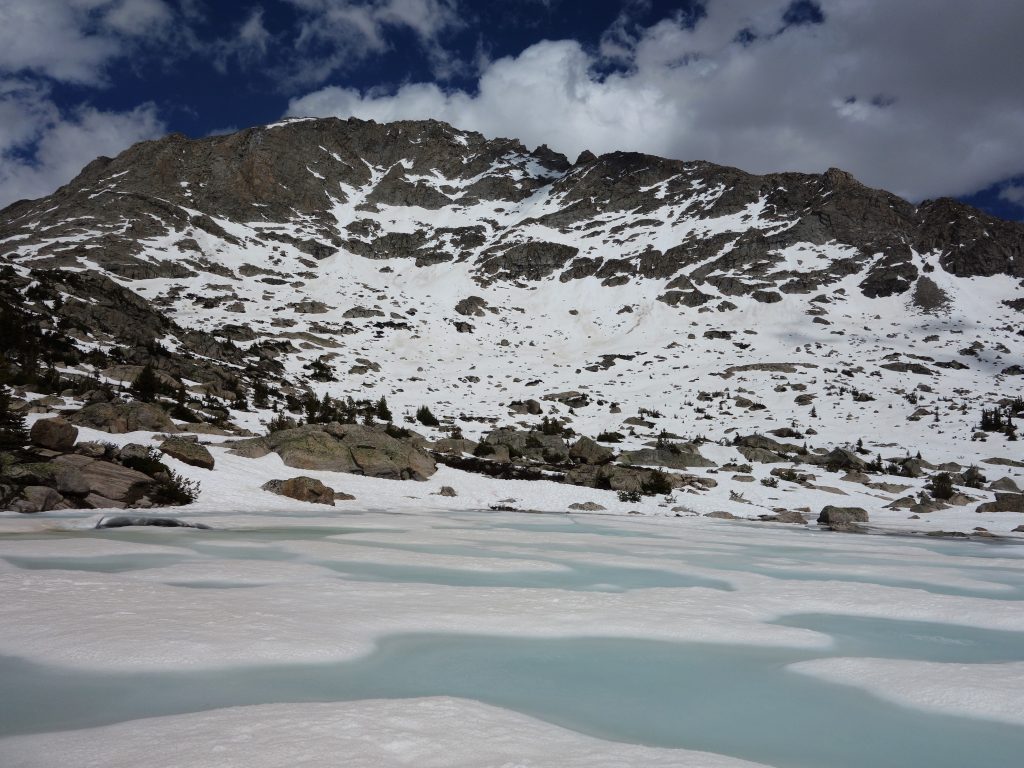
Continuing to the base of the peak, I skinned up to the base of the couloir, then had to boot up further. Hiking up, I found the couloir to be pretty steep, about 45 degrees like I expected, but the snow was definitely soft enough that it would not be survival skiing. At its narrowest, the couloir was maybe 20 ft. This was going to be an awesome descent!

After a bit of hiking, I reached the top of the ridge. Peering over the other side, it was near vertical snow dropping off! I radioed to Kylie, got myself pumped up, and started down. It was near perfect corn and I ripped steep turns, linking all of the couloir with just one or two rests in between. It was so much better than the icy skiing on Gannet! Considering I had only been skiing for two years, it felt so awesome and vindicating to shred such a steep, exposed couloir on a big mountain deep in the wilderness like this. This is what ski mountaineering is all about!

There was a little 20 degree slope near camp, so I decided to skin up for some easy, calm turns. When I reached the top, Kyle radioed me to let me know he was about to ski down the couloir. I was able to watch the little black dot of Kyle ski down the 1300 ft slope. He looked awesome!
Then, I slowly skied down my tiny slope with pretty S turns. Somehow we met each other at the creek crossing near camp. That boy is speedy!
Day 5: Back to Civilization
When I woke up in the morning, my lips were so swollen I could see them. They hurt really, really bad. When we started off back to the car, I felt like someone was slapping me across my face every time I took a breath.
Kyle was so patient as I slowly skinned in silence. About 2 miles in for the morning, I had a meltdown. My legs were tired, the skinning was scary side-hilling, I felt like I didn’t have control, and my lips were on fire.
Kyle carried my skis for the rest of the day.
I trotted along behind him, post-holing like crazy.

I was blown away by the response of the people that we passed on the way out. No one said anything or judged Kyle for carrying my skis. It was like it was expected that the girlfriend was too weak and tired to complete the objective. And for this trip, it was true.
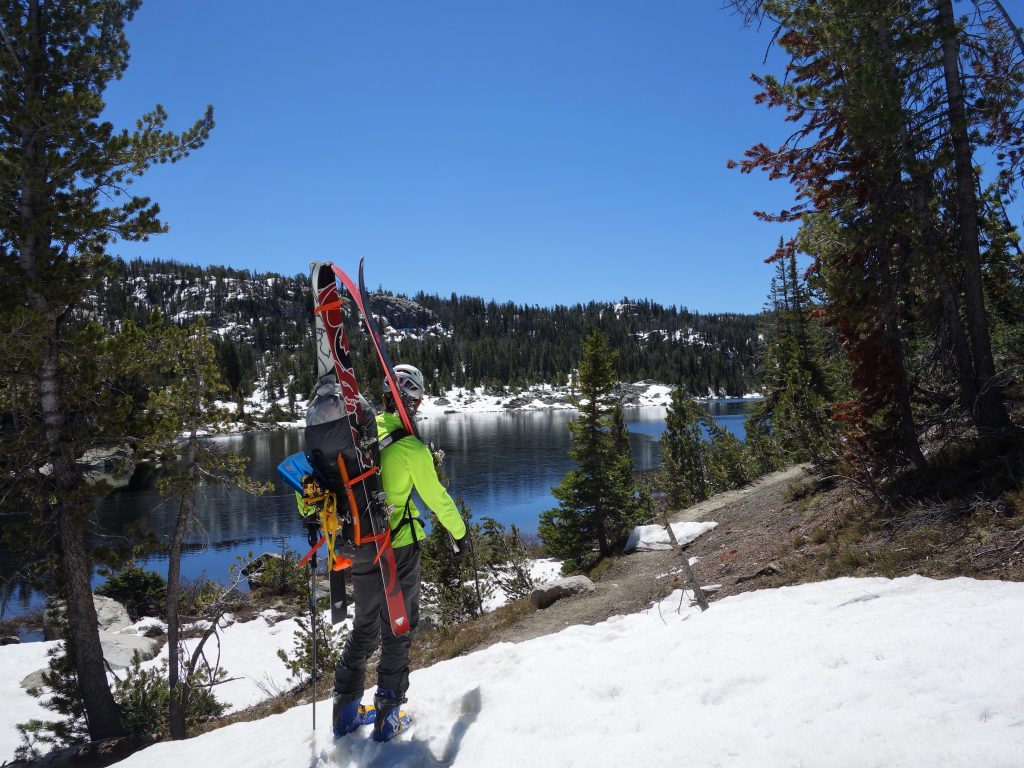
We had heard that once we got to Photographer’s Point, the snow was suppose to be gone from the trail. This was the optimistic checkpoint I was excited for all day.
When we reached the point, we got to see a beautiful view of Titcomb Basin from a distance. It also illustrated the rolling terrain we struggled to tour over.
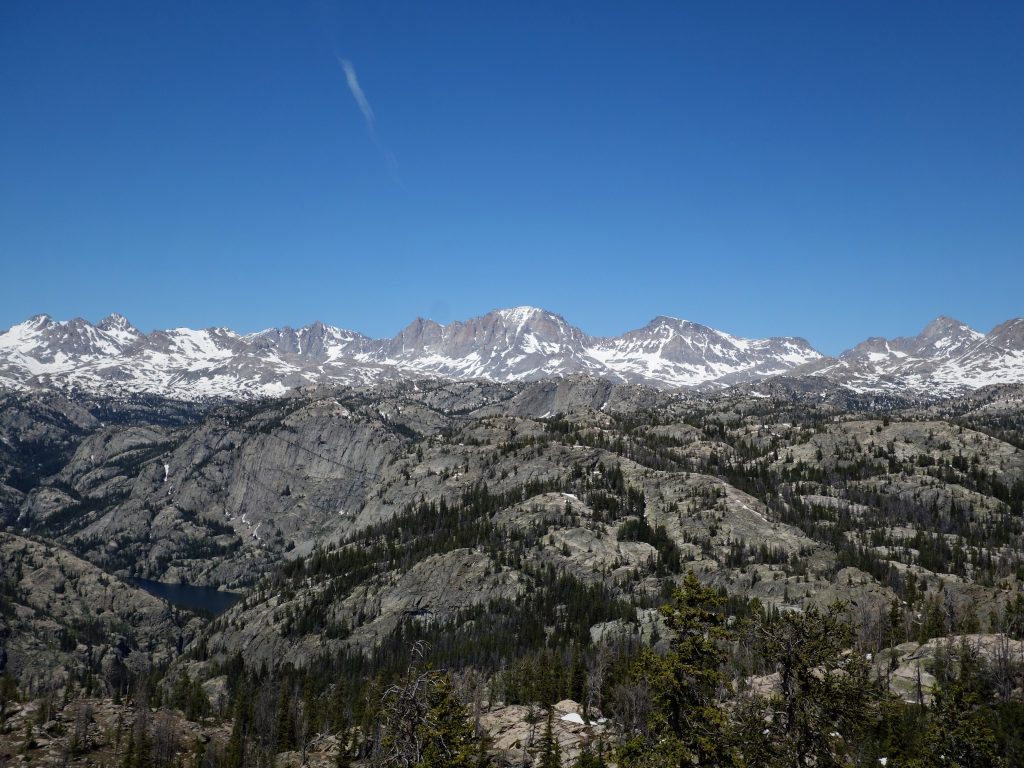
After Photographer’s Point, the day became a normal grind. I carried my skis down the melted, muddy trail. Walking was something that was familiar, and I was happy to be on reliable ground.
We reached the car and packed up to head to Pinedale. My lips had started to blister. It was time for a serious milkshake.
Reflections:
Overall, this has been the hardest trip I have completed. (Even harder than climbing the Grand Teton with a broken foot). It made me seriously evaluate if I had the strength to finish the summer with Kyle.
I learned the feeling of altitude sickness and the importance of wearing sunscreen. I also learned the importance of being the weakest link in a partnership. By putting myself in danger, I was also putting Kyle in danger.
This trip showed how much weight Kyle can pull in our partnership. How much he is concerned of my well-being. How flexible our trip planning can be.
Really, I learned how strong I am both internally and externally.
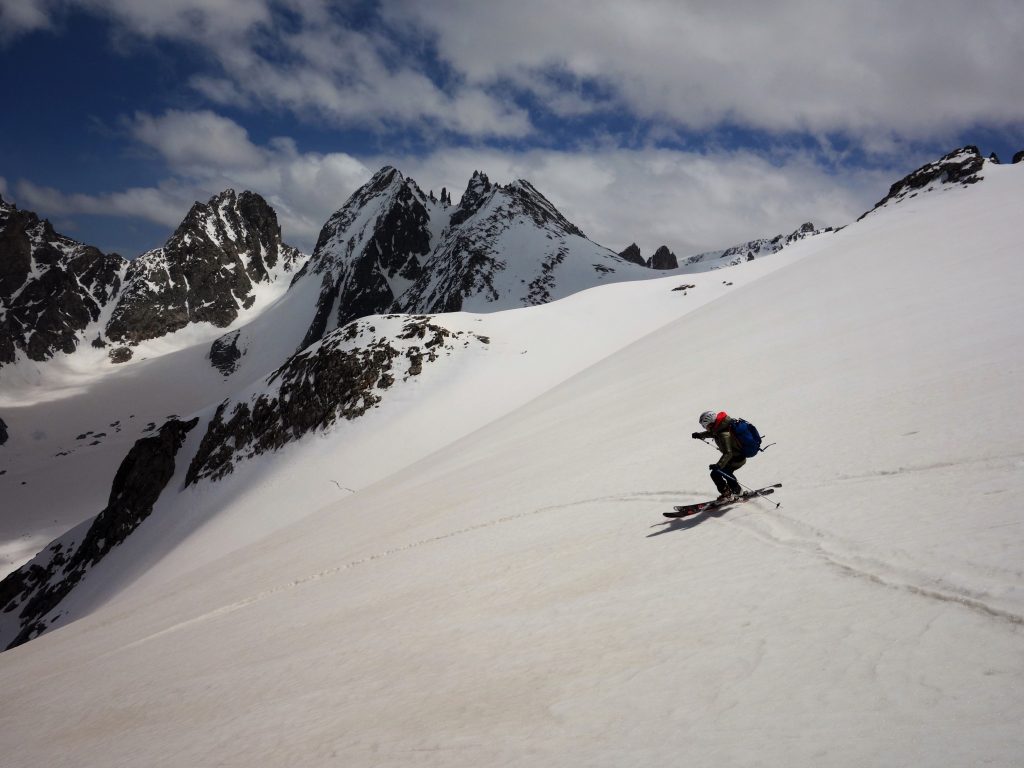
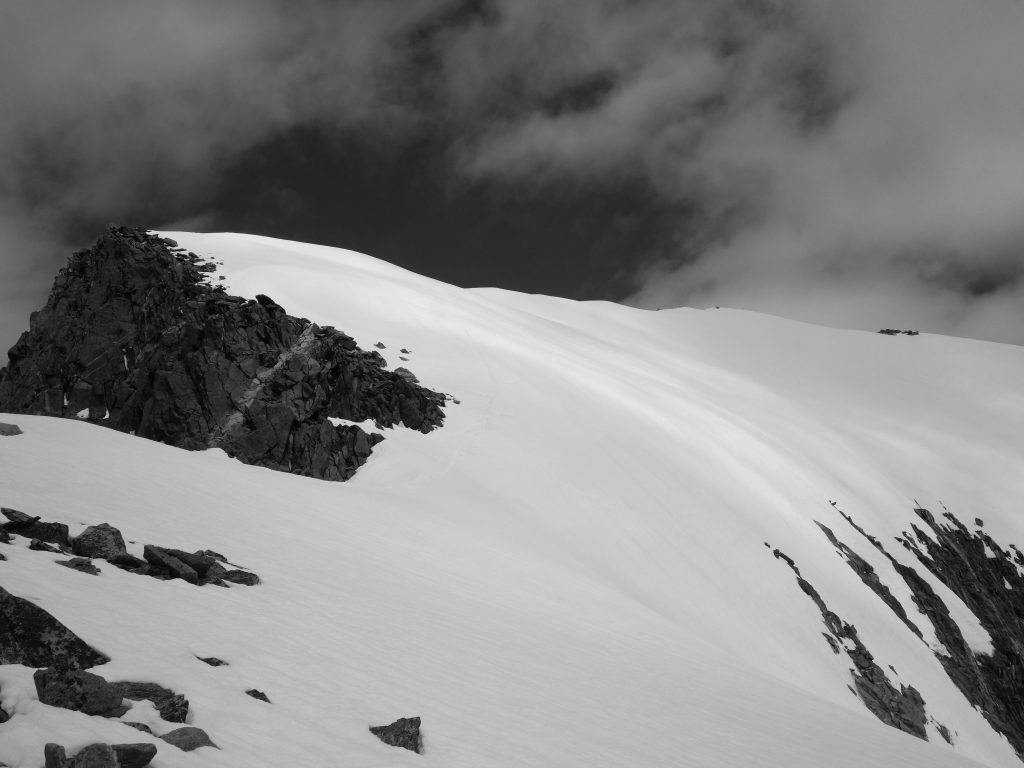
what month did you guys go?
Early June.